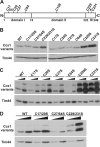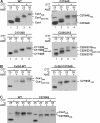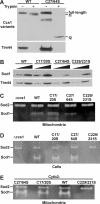Mitochondrial Ccs1 contains a structural disulfide bond crucial for the import of this unconventional substrate by the disulfide relay system
- PMID: 21865601
- PMCID: PMC3192856
- DOI: 10.1091/mbc.E11-04-0296
Mitochondrial Ccs1 contains a structural disulfide bond crucial for the import of this unconventional substrate by the disulfide relay system
Abstract
The copper chaperone for superoxide dismutase 1 (Ccs1) provides an important cellular function against oxidative stress. Ccs1 is present in the cytosol and in the intermembrane space (IMS) of mitochondria. Its import into the IMS depends on the Mia40/Erv1 disulfide relay system, although Ccs1 is, in contrast to typical substrates, a multidomain protein and lacks twin Cx(n)C motifs. We report on the molecular mechanism of the mitochondrial import of Saccharomyces cerevisiae Ccs1 as the first member of a novel class of unconventional substrates of the disulfide relay system. We show that the mitochondrial form of Ccs1 contains a stable disulfide bond between cysteine residues C27 and C64. In the absence of these cysteines, the levels of Ccs1 and Sod1 in mitochondria are strongly reduced. Furthermore, C64 of Ccs1 is required for formation of a Ccs1 disulfide intermediate with Mia40. We conclude that the Mia40/Erv1 disulfide relay system introduces a structural disulfide bond in Ccs1 between the cysteine residues C27 and C64, thereby promoting mitochondrial import of this unconventional substrate. Thus the disulfide relay system is able to form, in addition to double disulfide bonds in twin Cx(n)C motifs, single structural disulfide bonds in complex protein domains.
Figures






Similar articles
-
Mia40-dependent oxidation of cysteines in domain I of Ccs1 controls its distribution between mitochondria and the cytosol.Mol Biol Cell. 2011 Oct;22(20):3749-57. doi: 10.1091/mbc.E11-04-0293. Epub 2011 Aug 24. Mol Biol Cell. 2011. PMID: 21865594 Free PMC article.
-
The disulfide relay system of mitochondria is required for the biogenesis of mitochondrial Ccs1 and Sod1.J Mol Biol. 2009 Jan 16;385(2):331-8. doi: 10.1016/j.jmb.2008.10.088. Epub 2008 Nov 7. J Mol Biol. 2009. PMID: 19010334
-
Structural and functional roles of the conserved cysteine residues of the redox-regulated import receptor Mia40 in the intermembrane space of mitochondria.J Biol Chem. 2009 Jan 16;284(3):1353-63. doi: 10.1074/jbc.M805035200. Epub 2008 Nov 14. J Biol Chem. 2009. PMID: 19011240
-
Structural basis for the disulfide relay system in the mitochondrial intermembrane space.Antioxid Redox Signal. 2010 Nov 1;13(9):1359-73. doi: 10.1089/ars.2010.3099. Antioxid Redox Signal. 2010. PMID: 20136511 Review.
-
A disulfide relay system in mitochondria.Cell. 2005 Jul 1;121(7):965-7. doi: 10.1016/j.cell.2005.06.019. Cell. 2005. PMID: 15989945 Review.
Cited by
-
Mia40-dependent oxidation of cysteines in domain I of Ccs1 controls its distribution between mitochondria and the cytosol.Mol Biol Cell. 2011 Oct;22(20):3749-57. doi: 10.1091/mbc.E11-04-0293. Epub 2011 Aug 24. Mol Biol Cell. 2011. PMID: 21865594 Free PMC article.
-
The oxidative protein folding machinery in plant cells.Protoplasma. 2013 Aug;250(4):799-816. doi: 10.1007/s00709-012-0463-x. Epub 2012 Oct 23. Protoplasma. 2013. PMID: 23090240 Review.
-
Redox-Mediated Regulation of Mitochondrial Biogenesis, Dynamics, and Respiratory Chain Assembly in Yeast and Human Cells.Front Cell Dev Biol. 2021 Sep 7;9:720656. doi: 10.3389/fcell.2021.720656. eCollection 2021. Front Cell Dev Biol. 2021. PMID: 34557489 Free PMC article. Review.
-
Cysteine Oxidations in Mitochondrial Membrane Proteins: The Case of VDAC Isoforms in Mammals.Front Cell Dev Biol. 2020 Jun 4;8:397. doi: 10.3389/fcell.2020.00397. eCollection 2020. Front Cell Dev Biol. 2020. PMID: 32582695 Free PMC article. Review.
-
A single-cysteine mutant and chimeras of essential Leishmania Erv can complement the loss of Erv1 but not of Mia40 in yeast.Redox Biol. 2018 May;15:363-374. doi: 10.1016/j.redox.2017.12.010. Epub 2017 Dec 23. Redox Biol. 2018. PMID: 29310075 Free PMC article.
References
-
- Allen S, Balabanidou V, Sideris DP, Lisowsky T, Tokatlidis K. Erv1 mediates the Mia40-dependent protein import pathway and provides a functional link to the respiratory chain by shuttling electrons to cytochrome c. J Mol Biol. 2005;353:937–944. - PubMed
-
- Arnesano F, Balatri E, Banci L, Bertini I, Winge DR. Folding studies of Cox17 reveal an important interplay of cysteine oxidation and copper binding. Structure. 2005;13:713–722. - PubMed
-
- Banci L, Bertini I, Cefaro C, Ciofi-Baffoni S, Gallo A, Martinelli M, Sideris DP, Katrakili N, Tokatlidis K. MIA40 is an oxidoreductase that catalyzes oxidative protein folding in mitochondria. Nat Struct Mol Biol. 2009;16:198–206. - PubMed
-
- Bien M, Longen S, Wagener N, Chwalla I, Herrmann JM, Riemer J. Mitochondrial disulfide bond formation is driven by intersubunit electron transfer in Erv1 and proofread by glutathione. Mol Cell. 2010;37:516–528. - PubMed
Publication types
MeSH terms
Substances
Grants and funding
LinkOut - more resources
Full Text Sources
Molecular Biology Databases
Miscellaneous

